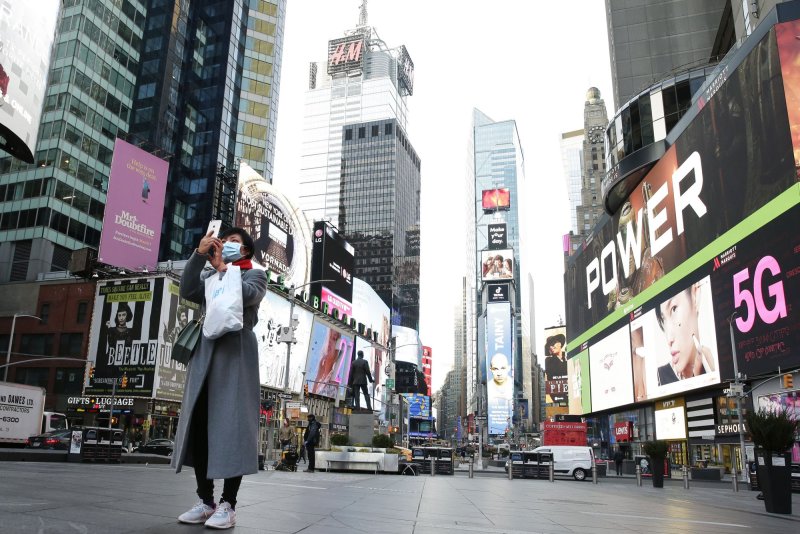A woman wearing a face mask stops to take a photo surrounded by zero nearby pedestrian traffic in Times Square in New York City on Wednesday. Photo by John Angelillo/UPI |
License Photo
March 19 (UPI) -- Amid reductions in gas emissions globally, scientific data Thursday shows New York City rush-hour traffic level has been reduced by 43 percent following new executive orders to control the new coronavirus.
Researchers say cutbacks in movement, including automobile traffic, in countries to counter the spread COVID-19 around the world has reduced global gas emissions in some of the busiest places on Earth.
The data tracking company TomTom said traffic congestion levels in New York City at 8 a.m. Thursday were 15 percent, down from comparable traffic the prior year when levels were 58 percent. TomTom uses the time spent driving during rush hour as part of its tracking of congestion levels throughout the day.
Traffic has been down in NYC since Monday when it dropped 35 percent over the prior year during the same hour following new executive orders from Gov. Andrew Cuomo and Mayor Bill de Blasio to curb the spread of coronavirus.
"What it means is people are not going out," said David King, a transportation planner and Arizona State University teacher. "They're not going to work, and you're seeing broadband demand drop off."
Cuomo announced a statewide ban on gatherings of more than 500 people Thursday, effectively shutting down Broadway temporarily, where all 41 theaters have at least 500 seats. The Broadway League said in a statement the suspension of performances would last through April 12. The Metropolitan Museum, the Metropolitan Opera and Carnegie Hall, also suspended visits and performances. The St. Patrick's Day Parade was also postponed.
Cuomo also said an at an earlier briefing that the City University of New York and State University of New York moved to a distance model for the rest of the spring semester.
President Donald Trump declared a national emergency in light of the coronavirus pandemic the next day.
By Monday, Cuomo announced a ban on gatherings of more than 50 people, all schools in New York state were closed for at least two weeks, casinos gyms and movie theaters were closed and bars and restaurants were limited to take out and delivery. And on Tuesday, De Blasio warned of a possibly sheltering in place in the next couple days as part of the city's plan to combat the coronavirus as the U.S. death toll surpassed 100, according to figures Monday from John Hopkins University' interactive global tracker with 6,330 confirmed cases.
On Thursday, the number of the confirmed cases in the United States had risen to 10,755 cases with 154 deaths.
New York researchers told the BBC early results show carbon monoxide largely from cars had been reduced by 50 percent over the prior year.
The decline in NYC traffic comes amid restrictions across the world to control the coronavirus, such as canceling flights and closing businesses.
In Italy, Milan saw a 64 percent decline in rush-hour traffic earlier this week and Rome saw a 67 percent decline, TomTom data shows.
Italy has more than 35,000 coronavirus cases and 2,978 deaths, according to the global tracker. The number of case in Italy is the largest number outside of China, which has more than 81,000 cases and 3,249 deaths.
Earlier this month, an update to a February report found that China's CO2 emissions had dropped by a quarter amid shutdown for coronavirus.
NASA and European Space Agency satellites detected significant drops in air pollution China, along with a sharp decline in pollution in Italy, amid the economic slowdown and shutdowns related to the coronavirus.
The coronavirus restrictions are certain to shrink gas emissions this year, according to climate scientists, but the slide will be temporary.
"I won't be celebrating if emissions go down a percent or two because of the coronavirus," said Rob Jackson, and environmental scientist at Stanford University, who chairs the Global Carbon Project. "We need sustained declines. Not an anomalous year below average."















